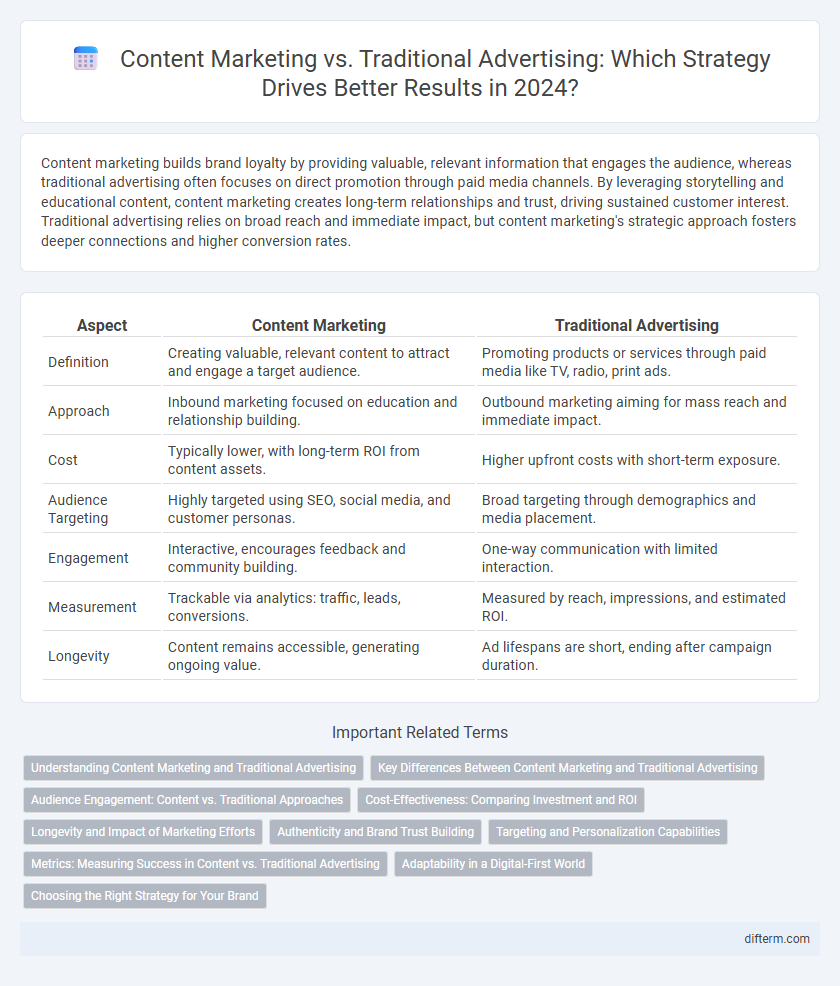Content marketing builds brand loyalty by providing valuable, relevant information that engages the audience, whereas traditional advertising often focuses on direct promotion through paid media channels. By leveraging storytelling and educational content, content marketing creates long-term relationships and trust, driving sustained customer interest. Traditional advertising relies on broad reach and immediate impact, but content marketing's strategic approach fosters deeper connections and higher conversion rates.
Table of Comparison
| Aspect | Content Marketing | Traditional Advertising |
|---|---|---|
| Definition | Creating valuable, relevant content to attract and engage a target audience. | Promoting products or services through paid media like TV, radio, print ads. |
| Approach | Inbound marketing focused on education and relationship building. | Outbound marketing aiming for mass reach and immediate impact. |
| Cost | Typically lower, with long-term ROI from content assets. | Higher upfront costs with short-term exposure. |
| Audience Targeting | Highly targeted using SEO, social media, and customer personas. | Broad targeting through demographics and media placement. |
| Engagement | Interactive, encourages feedback and community building. | One-way communication with limited interaction. |
| Measurement | Trackable via analytics: traffic, leads, conversions. | Measured by reach, impressions, and estimated ROI. |
| Longevity | Content remains accessible, generating ongoing value. | Ad lifespans are short, ending after campaign duration. |
Understanding Content Marketing and Traditional Advertising
Content marketing centers on creating valuable, relevant content to engage targeted audiences and build long-term brand loyalty, contrasting with traditional advertising's emphasis on direct promotion and immediate sales impact through paid media channels like TV, radio, and print. Content marketing leverages blogs, social media, and videos to foster trust and educate consumers, while traditional advertising relies heavily on one-way messaging and repetitive exposure. Understanding these differences is crucial for marketers aiming to optimize reach, engagement, and conversion metrics across diverse consumer touchpoints.
Key Differences Between Content Marketing and Traditional Advertising
Content marketing focuses on creating valuable, relevant, and consistent content to attract and retain a clearly defined audience, whereas traditional advertising relies on paid placements to deliver direct promotional messages. Content marketing builds long-term relationships and brand loyalty through storytelling and educational materials, while traditional advertising emphasizes immediate sales and brand awareness with interruptive tactics. Key differences include engagement style, audience targeting precision, cost efficiency, and measurement of return on investment.
Audience Engagement: Content vs. Traditional Approaches
Content marketing drives higher audience engagement by delivering valuable, relevant information that fosters trust and long-term relationships, whereas traditional advertising often relies on interruptive messages that can lead to ad fatigue. Interactive content such as blogs, videos, and social media posts encourages active participation, boosting brand loyalty and repeat interactions. In contrast, traditional advertising methods like TV or print ads typically offer one-way communication with limited engagement metrics.
Cost-Effectiveness: Comparing Investment and ROI
Content marketing typically requires lower upfront investment compared to traditional advertising, leveraging organic reach and targeted audience engagement to drive long-term ROI. Traditional advertising often demands significant budgets for media buying and production, with ROI measured in immediate but sometimes short-lived sales spikes. Marketers prioritize content marketing for its scalability and sustained cost-effectiveness, resulting in higher cumulative returns over time.
Longevity and Impact of Marketing Efforts
Content marketing generates sustained engagement by providing valuable, relevant information that builds long-term customer trust and brand loyalty, unlike traditional advertising which relies on short-term, interruptive messages. Studies show content marketing produces 3 times more leads per dollar spent and maintains audience interest over months and years. Brands leveraging content marketing experience higher lifetime customer value and improved search engine visibility, resulting in lasting impact and cost-effective growth.
Authenticity and Brand Trust Building
Content marketing fosters authenticity by delivering valuable, relevant information that resonates deeply with target audiences, enhancing brand trust through genuine engagement. Traditional advertising often relies on polished messaging and mass reach, which can sometimes feel intrusive or insincere, limiting emotional connection. Brands prioritizing authentic storytelling and consistent content creation typically achieve stronger loyalty and credibility compared to those focusing solely on conventional ad campaigns.
Targeting and Personalization Capabilities
Content marketing leverages advanced data analytics and audience insights to deliver highly targeted and personalized messages that resonate with specific customer segments, enhancing engagement and conversion rates. Traditional advertising often relies on broad demographic targeting through mass media channels, resulting in less precise audience alignment and lower personalization. The superior targeting capabilities of content marketing allow brands to tailor content dynamically, optimizing user experience and driving higher ROI compared to conventional advertising methods.
Metrics: Measuring Success in Content vs. Traditional Advertising
Content marketing emphasizes metrics such as engagement rates, time spent on page, and lead generation to gauge effectiveness, reflecting deeper audience interaction and brand affinity. Traditional advertising primarily relies on reach, frequency, and conversion rates, focusing on immediate sales impact and broad audience exposure. Digital tools enable more precise measurement in content marketing, offering insights into customer behavior and ROI that traditional advertising often struggles to capture accurately.
Adaptability in a Digital-First World
Content marketing demonstrates superior adaptability in a digital-first world by enabling real-time audience engagement and personalized messaging tailored to user behavior. Unlike traditional advertising, which relies on static campaigns and fixed schedules, content marketing leverages data analytics and social media platforms to optimize content delivery dynamically. This flexibility enhances brand relevance and drives higher conversion rates in rapidly evolving digital landscapes.
Choosing the Right Strategy for Your Brand
Content marketing drives long-term engagement by delivering valuable information tailored to target audiences, fostering brand loyalty and trust. Traditional advertising generates immediate impact through broad-reaching campaigns that boost brand visibility and sales in the short term. Selecting the right strategy depends on your brand's goals, with content marketing suited for sustained growth and traditional advertising effective for rapid market penetration.
content marketing vs traditional advertising Infographic

 difterm.com
difterm.com